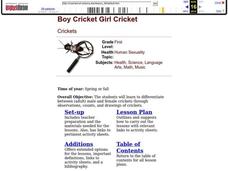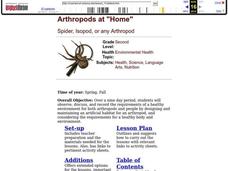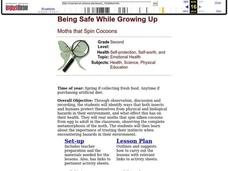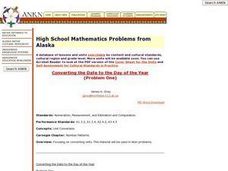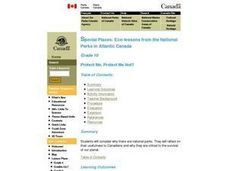Curated OER
Is the Ruble Becoming Rubbish?
Students analyze the effects of economic turmoil on the Russian economy and relate them to the local economy and their own lives. They trace the ripple effect of a troubled economy from a local business to the rest of the community.
Curated OER
You Light Up My Life
Students examine the relationship between solar activity and the Earth's geomagnetic field in producing the phenomena known as aurora borealis (Northern Lights) by reading and discussing "Earth, Wind and Fireworks." students graph data...
Curated OER
Cars on the Curve
Second graders, using two dice, participate in a car race game called Cars on the Curve. They predict which car wins the game and records it in their Data Diary.
Curated OER
You Are Smarter Than The Ads
Fourth graders examine advertising techniques and create original designs for advertisements in this three day, 4th grade art/social studies instructional activity. The instructional activity includes assessment ideas, resource...
Curated OER
Carrot Sticks or French Fries?
Young scholars investigate the influence of fast food brand names on food choices and analyze the factors that contribute to branding preferences. They write an opinion essay on the corporate responsibility to influence food choices.
Curated OER
The Same But Different
In this rock comparison worksheet, students read an information chart about common igneous rocks. Then students answer 7 questions about what they've read.
Curated OER
Counting Animal Populations
Students learn how to count animal populations by the Mark and Recapture method. In this counting animal populations lesson plan, students begin by predicting amounts of different candies in a jar. Students then simulate using beans, two...
Curated OER
Discovering the Wetlands!
Students name wetland plant and animal life. In this ecosystem lesson students go birdwatching and interpret native plants through art.
Curated OER
Head, Shoulders, Knees & Toes
Students, through observation of crickets, recognize and use proper names for human and insect body parts. They compare and contrast parts of human and insect body parts.
Curated OER
Think Safe! Be Safe!
Students predict, observe, and explain how pillbugs, grasshoppers, stink bugs, and humans stay safe and protect themselves.
Curated OER
Boy Cricket Girl Cricket
First graders differentiate between (adult) male and female crickets through observations, counts, and drawings of crickets.
Curated OER
Arthropods at
Young scholars observe, discuss, and record the requirements of a healthy environment for both arthropods and people by designing and maintaining an artificial habitat for an arthropod.
Curated OER
Being Safe While Growing Up
Second graders identify ways that both insects and humans protect themselves from physical and biological hazards in their environment. They rear moths from egg to adult and consider the importance of trusting their own instincts.
Curated OER
High School Mathematics Problems from Alaska: Dog Lot Math
Learners determine the cost of feeding dogs during the winter and summer months when using commercially produced dog food.
Curated OER
Dog Lot Math
Learners use their problem-solving skills to answer math problems. They determine the cost of feeding sled dogs. They share their answers with the class.
Curated OER
Stink-O-Rama
Young scholars participate in activities that require them to follow clues. In this clues lesson, students do different activities that involve looking and thinking about clues to get them to their answer.
Curated OER
Food Math
Pupils brainstorm healthy food choices. In this health science lesson, students calculate how much of each food group they need daily. They plan a menu based on the "MyPyramid for Kids" food guide.
Curated OER
Ozone Layer
Seventh graders develop an understanding of the ozone layer, it's affect on Earth, and the effect of human activity on the ozone layer. They then interpret data from satellite pictures and develop an understanding of longitude/latitude...
Curated OER
High School Mathematics Problems from Alaska: Converting the Date to the Day of the Year
Learners focus on converting the date to the day of the year to use to solve problems.
Curated OER
Protect Me, Protect Me Not?
Students brainstorm natural resources found in Canadian National Parks. They, in teams, defend and support conservation efforts and give a presentation. Evaluation consists of speaking on both pro and con sides of a national parks' issue.
Curated OER
Species and Spaces - At Risk at Home
Eleventh graders explore and compare Canadian biomes and investigate species at risk. They describe population growth and eco-regions in terms of climate and geography. They research and create presentations about the natural history and...
Curated OER
Matter And Its Changes
Fifth graders explore the phases of matter, make observations of matter, the physical and chemical properties of matter, solutions and mixtures, formation of molecules and atoms and molecules all through hands on activities.
Curated OER
Examining Ways to Organize Questions and Answers Within a Text
Young scholars study questions and answers within a text to learn about writing structure and organization. In this writing structure lesson, students investigate books in class by asking questions for the text. Young scholars then...
Curated OER
The Miracle Fish: Learning to Design an Experiment
Learners develop procedures to explore the behavior of fish. In this scientific experiment lesson students from a hypothesis, write a question, identify different variables and controls in their experiment.












